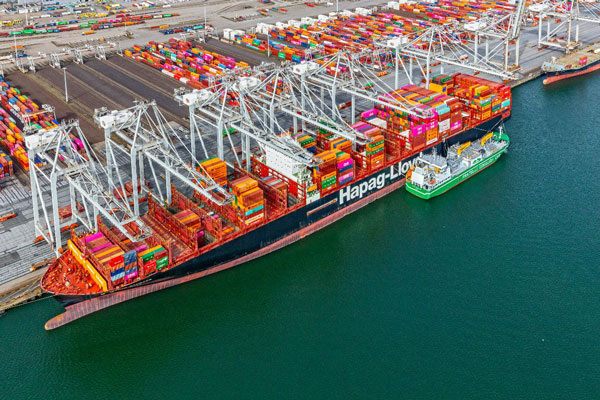
Delivering LBM to Hapag-Lloyd’s Brussels Express container ship
Hapag-Lloyd takes largest ship-to-ship LBM delivery
AMSTERDAM, 20 days ago
Titan Clean Fuels and STX Group have successfully concluded a ship-to-ship bunkering of 2,200 metric tonnes of LBM to a Hapag-Lloyd container vessel in the port of Rotterdam.
This transaction marks Hapag-Lloyd’s entry into using liquefied biomethane (LBM) as sustainable shipping fuel, representing the largest ship-to-ship bunkering operation known to date.
STX Group and Titan Clean Fuels have collaborated to liquify, store and deliver mass-balanced biomethane in Zeebrugge in Belgium under ISSC certification fully recognised under the European Union´s Renewable Energy Directive known as RED II.
Possible and scalable
“This pioneering deal demonstrates that bunkering large quantities of liquefied Biomethane is possible and scalable. However, there is still more progress required regarding the necessary infrastructure and the regulatory framework. For us, bunkering liquefied Biomethane is another measure in our step-by-step approach to further decarbonise our operations to reach our goal of becoming net-zero by 2045,” said Jan Christensen, Senior Director Fuel Purchasing at Hapag-Lloyd.
"Titan’s Alice Cosulich bunker vessel has successfully delivered LBM to Hapag-Lloyd’s Brussels Express container ship. We’d like to thank all the partners involved for another smooth operation. We have been encouraged by the demand for LBM so far, and this major bunkering represents a significant step in shipping’s clean fuels transition. Titan recognises the LNG pathway via LBM and renewable e-methane as a practical, sustainable and cost-effective route to net-zero shipping emissions available today. We work every day towards full regulatory compliance for shipowners and operators of deep sea ships,” commented Caspar Gooren, Director of Renewable Fuels at Titan Clean Fuels.
“We congratulate Hapag-Lloyd on this landmark deal in the shipping sector. This transaction is a proof of how liquefied biomethane can be a powerful tool on the path to a lower carbon transport sector. At STX Group, we are proud to consistently be at the forefront of environmental markets and this is yet another example of how we are building long-term value through high-impact use cases,” said Sead Keric, Managing Partner of Renewable Gas at STX Group.
Sustainable bunker fuel
LBM, also known as bio-LNG, is an established sustainable bunker fuel that can even be net-zero emissions depending on the feedstock and is commercially available in Europe, Asia and North America. Biomethane is produced from sustainable biomass feedstocks such as industrial and agricultural waste streams that do not compete with food production. These are nationally or regionally defined, for example by the EU (RED II) in Europe and the EPA (Renewable Fuel Standards) in the USA.
LBM can be delivered in the form of physical molecules or “Mass Balanced” whereby biomethane is injected into the gas network and transported to liquefaction plants and LNG terminals using the existing infrastructure through a system of mass balancing. Mass balancing is expected to be a feature on many alternative fuel pathways and offers a practical way of delivering the volumes of clean marine fuel the shipping industry requires.--TradeArabia News Service







